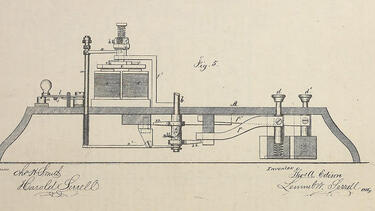Why Do Women Inventors Win Fewer Patents?
An analysis of patent applications by Yale SOM researchers found that women inventors are less likely to have their patent applications approved than men. But that disparity dips if an examiner can’t guess an inventor’s gender from her name. The researchers argue that eliminating the disparity is crucial to increasing innovation in the economy.

A drawing of an improved telegraph machine from an 1869 patent application by Thomas Edison.
By Jyoti Madhusoodanan
In the United States, women earn half of the doctoral degrees in science and engineering. But when it comes to patenting their inventions, they trail far behind men: Only 10% of patent-holders are women. Even in the life sciences, where women earn more than half of new PhDs, only 15% of inventors listed on patents are women. According to a new analysis by Kyle Jensen, Balázs Kovács, and Olav Sorenson of Yale SOM, published in Nature Biotechnology, this disparity stems in part from how patents are obtained and maintained over time.
Gender-based disparities have been found in orchestras, academic publication, and many other areas. But understanding the imbalance with patents has been historically difficult because the U.S. Patent and Trademark Office (USPTO) only offered information on one patent at a time. A recent bulk data release enabled Jensen, Kovács, and Sorenson to trace the histories of 2.7 million patents issued between 2001 and 2014. They analyzed maintenance fee payments, prosecution histories, and the full text of patents, which revealed the interactions between inventors and examiners as well as how a patent claim was altered during the process of filing.
Read the study: “Gender differences in obtaining and maintaining patent rights”
The researchers then used information from Social Security Administration and commercial databases to determine the probable gender of inventors listed on patents.
They found that overall, women inventors’ patents were more likely to be rejected than those filed by teams of men. When rejected, women’s applications were 2.5% less likely to be appealed. When applications were granted, women’s patents often had more words added that reduced the scope of their patents.
This dilution of the language in a patent is significant because adding clauses can make a patent weaker, Jensen explains. Consider a patent filed for “a vessel that holds fluids” versus “a vessel that holds fluids which also has a handle.” The more specific patent, he explains, is weaker: “Because it covers fewer things, a patent that is less broad is less valuable.”
Even approved patents fared poorly: women’s patents were maintained less often by their assignees (the patent owner), and received fewer citations from other inventors and from patent examiners. “It’s surprising just how ubiquitous the negative effects are,” Jensen says. “It's not just across one metric. They are less likely to have their patents accepted. Fewer claims are granted. The claims are longer, less often maintained, less often cited.”
Why the difference? It’s hard to tell based on the current data. However, the researchers devised a way to glean some insight based on the first names of inventors listed on applications.
While the applicant, their employers, and attorneys would be aware of whether the inventor was a man or woman, patent examiners likely deduced an inventor’s gender based on the names listed on an application. That’s easy with common names such as Mary or Robert, but tougher with rare names, such as Jameire or Malaeka. These names are male and female, respectively and almost exclusively, but most people don’t know it.
The researchers found that women inventors with common names had an 8.2% lower chance of getting their patents approved. But the difference in probability of approval fell to 2.8% for those with rare names, where it would be tougher for an examiner to guess the applicant’s gender.
When it came to future citations, patents that listed common female names were cited 30% less frequently than those held by people with common male names. That disparity did not simply vanish for women with rare names; it actually reversed. Their patents were cited approximately 20% more frequently than patents listing rare male names.
These preliminary results suggest that “essentially, women inventors must pass greater degrees of scrutiny,” Jensen says. “But conditional upon being granted, the average patent issued to women is actually of superior quality than the average patent issued to men.”
One solution, the researchers say, could be to further anonymize the process of obtaining a patent. For example, applications could list only the inventors’ initials, and exchanges between the applicants and examiner could be restricted to a platform that ensures anonymity.
Creating an equal playing field in the patent process is not just for the benefit of women. Technical progress, one of the primary drivers of economic growth, is boosted when inventors can lay legal claim to their innovations, allowing them to profit from them and helping those who want to build future work based on an existing patent. By increasing fairness in the patent system, we can help bring more good inventions to the forefront. And that, the researchers write, has the potential to create greater prosperity.